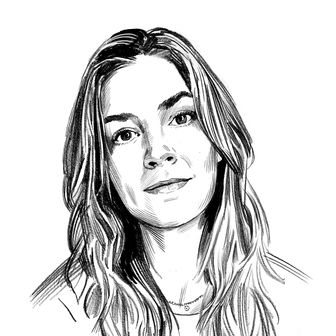
Minding Our Business: A series on what it takes to work for yourself.
Many people, when they read about a piece of art selling for millions (or even thousands) of dollars, may assume a pretty lucrative deal for the person who made it; that when a Kerry James Marshall went for a record-breaking $21 million at Sotheby’s in 2018, for example, Marshall made a killing. In fact, he didn’t see a cent from the sale, because the U.S. lacks the droit de suite rights that provide for artist royalties on future purchases. When Charlie Jarvis helped launch the company Fairchain in 2019, Jarvis — then a student at Stanford, now 25 and the co-founder of an art-tech company — didn’t know about that caveat, either. “I had been seeing all of these, I thought, really inspiring stories about women artists and artists of color who were finally getting their time in the spotlight, finally having their works go for millions of dollars at auction,” she says. “When I learned about the compensation structures, that those artists weren’t getting compensated from those grand auctions, I thought to myself, I guess this maybe isn’t the moment of equality that I thought it was. That definitely felt like a lightbulb moment.”
Jarvis’s co-founder, Max Kendrick, was intimately familiar with the setup. The son of sculptor Mel Kendrick, he knew artists lose out on U.S. resale royalties in perpetuity and enlisted Jarvis to help him build a solution. Kendrick was at business school, and Jarvis was studying computer science; at Fairchain, she created a platform that uses the blockchain to create digital certificates of title and authenticity for artworks. That code not only makes a piece easier to track; it also gives the artist an opportunity to build in a commission on future sales. Jarvis has previously described Fairchain’s product, a title-management and transaction system, as “deliberately unsexy” in a sexy industry — a “simple solution,” she explains, “that respects a lot of the norms of the market,” while adding “an important layer of equity and accessibility for artists, galleries, and collectors alike.”
What about Fairchain inspired you from the beginning?
I met Max, my co-founder, at Stanford. I was studying computer science and then, separately, taking art classes on the side. I had a friend at the engineering school who took a class at the business school and, one day, kind of cryptically introduced me to this other person she said I had to meet with who was working on a project related to art. The idea was, Is there a way that we can give artists resale royalties? I was studying studio art but didn’t know much about the art market — I had spent some time interning in the music tech space, though, and it was really cool to see just how transformative technology was to that industry, as far as accessibility and creative access. The art world was this really tech-unsaturated landscape: People are still sending invoices via email. Gallerists would tell me about how they received payments in suitcases full of cash. What if we could be the ones to create this technical infrastructure for the art market and make sure that it’s designed from the outset in a way that feels brilliant and efficient but also sustainable and equity-first?
Did you have any mentors who’ve helped you along the way?
One of my biggest mentors was the product manager on my first team at Google. While I was in school, I did an internship on his team. He’s the one who convinced me to switch my major from design to computer science, and he’s the one who told me that I would never feel completely ready to start a company, but if it was what I wanted to do, I just had to dive in. But he always said that when you’re interviewing candidates, the best thing you could see on someone’s résumé is that they started a company and failed. That gave me the boldness to pursue this kind of risky thing: I knew it would be a valuable experience regardless.
Were there people who, in the ideas phase, discouraged you? What kind of feedback did they give you?
I spent a lot of my education in these environments where there was always one really clear path to success: You would go from school to a name-brand consulting firm, or you’d go to a big-tech company. So the idea of going off that path, and going into a role with a lot of uncertainty, I definitely felt like the people around me, my classmates, sometimes reacted pretty strongly to that kind of thing. But I know that in order for me to succeed in anything, I need to be passionate about it. I need to care about the thing I’m doing and feel that I can see the tangible impact of the work that I’m making. I knew in my heart that it was a better fit for me than to do some of the things that other people considered more prestigious. And then when we were starting off building the actual company, there were so many people who said, “The art market is too traditional; they’ll never adopt this degree of technology.” I’d be surprised if you were building anything new and nobody pushed back. In the beginning, you get a bunch of people saying, “Oh, this could never exist — not that it’s a bad idea, necessarily, but that there’s no path to adoption.” Reaching these moments of validation where suddenly people see that this could be a reality and suddenly are very bought-in, it’s a cool transition to watch.
Was there a moment when things really started to come together and you were seeing this as, Oh, this could be really successful, it’s working?
Early in our first year, it was me, Max, my friend Noah, who’s a designer, and my other friend Blake, who was taking a year to do internships during the pandemic, and that’s when we built up this first version of the platform. We found a partner who was doing a benefit art sale called Art for Black Lives, and then to convince them to let us partner with them, we said, “Hey, we’ll handle all the fulfillment; it’ll be super-easy for you guys.” The next few weeks, I basically lived in our designer’s home while Blake and I were coding the platform, and once we launched, we were running all around New York City, printing the works and getting artist signatures and sending them to the shipping facilities. It was this really cool moment of getting the product into people’s hands and seeing how well received it was and seeing how excited the artists were to participate. In the beginning, there are so many questions and so many hypothetical reasons why things can’t work, so that moment when you have a first version of the product, get it out into the world, and can see people using it and see people excited about it is really special.
What did you have to lose, potentially, by starting Fairchain? And did you actually lose it?
You worry that you’re losing out on years of corporate experience, on tech income — when I started the job, I wasn’t taking a salary — and I also work all the time, so I think about how I’m missing out on things like spending time at bars with my friends. All of that. But I don’t have as many things to lose as a lot of people, right? When you’re young, you have the lowest risk profile: I have no kids, no mortgage. If anything, I feel like I have so much to learn. So even if everything ended and I had to start over, I don’t think I would be starting at square one. I think I would be able to take all of the learnings and the incredible community I’ve built and the ways that I’ve grown with me. And that feels invaluable.
How did you get the money to start the business, and if you have ever had to ask for funding, how did you do it, who did you ask, how did you go about it, how did that feel? We are definitely a venture-funded business. We started off using our savings, but the first bit of money we got by doing a big friends-and-family round, and really quickly that expanded to artists investing, academics, operators, former mentors — our first investors were people who really believed in our mission and had a depth of knowledge in some realm that was advantageous to business. They ended up being this power circle of people I really admired. And after we launched, we raised institutional funding, from introductions to VCs by other people who believed in us, whether they be friends or our other investors.
Raising money is really intimidating at first, and I remember feeling like the numbers we were talking about were just so huge. I had never encountered that much money before, and I didn’t know how to ask for it. But a lot of building a business is asking people for things, and there’s an ideological shift that has to happen where you understand that you might be asking someone for something but you’re also providing them with something valuable. There was a moment where it went from, I’m asking you to take a risk on me to I’m giving you the opportunity to be involved in this company and potentially have a stake in the upside. I used to think that it was this scary, PowerPoint presentation to a boardroom full of investors; now, I really think of it as a fun, two-way conversation between potential ideological partners. Now, I’m not scared of it at all and I kind of find it fun.
Starting a business from scratch has got to be very stressful with a high potential for burnout. So what do you do to regroup?
I’ve given up on thinking that there won’t be stress in my life or that I’m going to have a regular work schedule. What I try to do is ground myself in having really good, healthy habits. I try to make time for a little exercise every day to give my mind some breathing room and to get some good endorphins. I end up coming up with the best solutions and ideas whenever I’m on a run. I also box on the weekends, which is really good for stress release, too. The other thing I do is hiring really good people and trusting them and delegating as much as possible, which I’m always working on getting better at, but ten times out of ten, it’s so important. Making time for fun and also making time for alone time is really important to me. I’ve learned to be pretty shameless about telling people even on the weekends that I can’t hang out, not necessarily because I have other plans but just explaining that I need to decompress, so I spend a lot of weekend evenings inside watching a movie or reading or something like that.
In general with stress management, the most important thing I’ve found is transparency and communication. When I’m delegating or when I’m not able to make certain plans because I’m busy working or taking me-time, or even when we’re going through business opportunities and deciding whether to pursue them or pass on them, I feel like being communicative and transparent about where I’m coming from helps me deal with stress as well as my own limitations.
More From This Series
- Anna Meacham Is a Problem Solver
- Working With Family Is Actually Possible
- They Started a Business While Bankrupt





